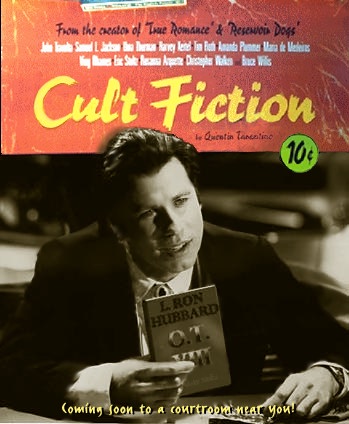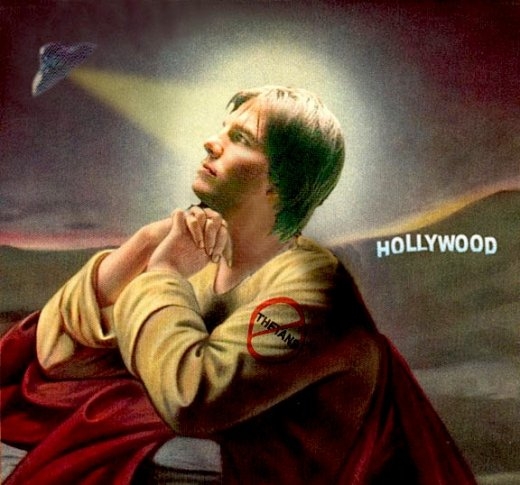DAILY NEWS: Jenna Miscavige Hill, herself a former member of the church, says Scientology caused her to become isolated from her family while she was growing up – an unofficial church policy often referred to as “disconnection” – and she no longer speaks with many relatives still in the church. “I feel that there is a good possibility that the Miscavige family would be better off if my grandpa had not found Dianetics,” she told the Daily News in an email yesterday. “I can’t say that if [he] didn’t find that, then he wouldn’t have found something else. But not a lot of other religions have a disconnection policy like [S]cientology does, so most likely I would at least be able to talk to my aunts and cousins.”
THE NEW YORKER: In his resignation letter, Haggis explained to Davis that, for the first time, he had explored outside perspectives on Scientology. He had read a recent exposé in a Florida newspaper, the St. Petersburg Times, which reported, among other things, that senior executives in the church had been subjecting other Scientologists to physical violence. Haggis said that he felt “dumbstruck and horrified,” adding, “Tommy, if only a fraction of these accusations are true, we are talking about serious, indefensible human and civil-rights violations.” Online, Haggis came across an appearance that Davis had made on CNN, in May, 2008. The anchor John Roberts asked Davis about the church’s policy of “disconnection,” in which members are encouraged to separate themselves from friends or family members who criticize Scientology. Davis responded, “There’s no such thing as disconnection as you’re characterizing it. […] We consider family to be a building block of any society, so anything that’s characterized as disconnection or this kind of thing, it’s just not true. There isn’t any such policy.” In his resignation letter, Haggis said, “We all know this policy exists. I didn’t have to search for verification—I didn’t have to look any further than my own home.” Haggis reminded Davis that, a few years earlier, his wife had been ordered to disconnect from her parents “because of something absolutely trivial they supposedly did twenty-five years ago when they resigned from the church. . . . Although it caused her terrible personal pain, my wife broke off all contact with them.” Haggis continued, “To see you lie so easily, I am afraid I had to ask myself: what else are you lying about?” MORE
DAILY NEWS: Rathbun and some other church defectors say Miscavige is nothing more than a 5-foot-5 bully who has physically attacked underlings for  no reason. Rathbun, who once defended Miscavige against such allegations, said that’s the dark side of his “Philly attitude.” “He loves to use the Philly banner to play the tough guy,” Rathbun said. Tales of Miscavige’s alleged violent outbursts have been recounted in the St. Petersburg Times, the Village Voice, on CNN and, most recently, in a lengthy piece in the New Yorker. The church has denied the allegations. “Not one of the sources making these allegations is credible; all have admitted to lying and being dishonest,” church spokeswoman Karin Pouw said in an email. Miscavige, who the church says is married with no children, has given only two interviews since assuming command. In those interviews, he said almost nothing about his childhood or family unless it related to Scientology. MORE
no reason. Rathbun, who once defended Miscavige against such allegations, said that’s the dark side of his “Philly attitude.” “He loves to use the Philly banner to play the tough guy,” Rathbun said. Tales of Miscavige’s alleged violent outbursts have been recounted in the St. Petersburg Times, the Village Voice, on CNN and, most recently, in a lengthy piece in the New Yorker. The church has denied the allegations. “Not one of the sources making these allegations is credible; all have admitted to lying and being dishonest,” church spokeswoman Karin Pouw said in an email. Miscavige, who the church says is married with no children, has given only two interviews since assuming command. In those interviews, he said almost nothing about his childhood or family unless it related to Scientology. MORE
THE NEW YORKER: In 1986, Hubbard died, of a stroke, in his motor home. He was seventy-four. Two weeks later, Scientologists gathered in the Hollywood Palladium for a special announcement. A young man, David Miscavige, stepped onto the stage. Short, trim, and muscular, with brown hair and sharp features, Miscavige announced to the assembled Scientologists that, for the past six years, Hubbard had been investigating new, higher O.T. levels. “He has now moved on to the next level,” Miscavige said. “It’s a level beyond anything any of us ever imagined. This level is, in fact, done in an exterior state. Meaning that it is done completely exterior from the body. Thus, at twenty-hundred hours, the twenty-fourth of January, A.D. 36”—that is, thirty-six years after the publication of “Dianetics”—“L. Ron Hubbard discarded the body he had used in this lifetime.” Miscavige began clapping, and led the crowd in an ovation, shouting, “Hip hip hooray!” Miscavige was a Scientology prodigy from the Philadelphia area. He claimed that, growing up, he had been sickly, and struggled with bad asthma; Dianetics counselling had dramatically alleviated the symptoms. As he puts it, he “experienced a miracle.” He decided to devote his life to the religion. He had gone Clear by the age of fifteen, and the next year he dropped out of high school to join the Sea Org. He became an executive assistant to Hubbard, who gave him special tutoring in photography and cinematography. When Hubbard went into seclusion, in 1980, Miscavige was one of the few people who maintained close contact with him. With Hubbard’s death, the curtain rose on a man who was going to impose his personality on an organization facing its greatest test, the death of its charismatic founder. Miscavige was twenty-five years old. MORE
THE NEW YORKER: Twelve other defectors told me that they had been beaten by Miscavige, or had witnessed Miscavige beating other church staff members. Most of them, like John Peeler, noted that Miscavige’s demeanor changed “like the snap of a finger.” Others who never saw such violence spoke of their constant fear of the leader’s anger. MORE
TAMPA BAY TIMES: Inside Scientology, A Times Investigation
VILLAGE VOICE: The U.S. Census Bureau, for example, provides at its website some very interesting data from Trinity College in Hartford, which has been surveying Americans about their religious affiliations for more than 20 years. In 2008, the school released its latest American Religious Identification Survey, based on talking to 54,000 Americans. There don’t seem to be any stories at the website about Scientology. Apparently, it’s just too small to be concerned about. How small? Well, brace yourself. According to the latest survey, the total number of people who identify as Scientologists is just 25,000 in this country of more than 300 million human beings. That’s one Scientologist for about every 12,000 Americans. In other words, the total number of active U.S. Scientologists is about the size of your run-of-the-mill local credit union. But there’s more. As paltry as that number is, the news is even worse for Scientology, because previous surveys by the same researchers show a steep drop in membership in recent years, reflecting anecdotal evidence that there’s been a “mass exodus” (as Reitman calls it) under the leadership of David Miscavige. In 1990, ARIS had found about 45,000 Scientologists. In 2001, it found 55,000, and in 2008, it found 25,000. Obviously, these are estimates, but you’d think Miscavige might be concerned to see the number of people willing to tell a researcher that they belong to the church of Scientology drop by more than half over a seven year period. MORE
WORTH REPEATING: Everything You Ever Wanted To Know About Scientology But Were Afraid To Ask

NEW YORKER: Everyone knew that the big revelations resided in level O.T. III. Hubbard called this level the Wall of Fire. He said, “The material involved in this sector is so vicious, that it is carefully arranged to kill anyone if he discovers the exact truth of it. . . . I am very sure that I was the first one that ever did live through any attempt to attain that material.” The O.T. III candidate is expected to free himself from being overwhelmed by the disembodied, emotionally wounded spirits that have been implanted inside his body. Bruce Hines, a former high-level Scientology auditor who is now a research physicist at the University of Colorado, explained to me, “Most of the upper levels are involved in exorcising these spirits.”
“The process of induction is so long and slow that you really do convince yourself of the truth of some of these things that don’t make sense,” Haggis told me. Although he refused to specify the contents of O.T. materials, on the ground that it offended Scientologists, he said, “If they’d sprung this stuff on me when I first walked in the door, I just would have laughed and left right away.” But by the time Haggis approached the O.T. III material he’d already been through several years of auditing. His wife was deeply involved in the church, as was his sister Kathy. Moreover, his first writing jobs had come through Scientology connections. He was now entrenched in the community. Success stories in the Scientology magazine Advance! added an aura of reality to the church’s claims. Haggis admits, “I was looking forward to enhanced abilities.” Moreover, he had invested a lot of money in the program. The incentive to believe was high.
In the late seventies, the O.T. material was still quite secret. There was no Google, and Scientology’s confidential scriptures had not yet circulated, let alone been produced in court or parodied on “South Park.” “You were told that this information, if released, would cause serious damage to people,” Haggis told me. Carrying an empty, locked briefcase, Haggis went to the Advanced Organization building in Los Angeles, where the material was held. A supervisor then handed him a folder, which Haggis put in the briefcase. He entered a study room, where he finally got to examine the secret document—a couple of pages, in Hubbard’s bold scrawl. After a few minutes, he returned to the supervisor.
“I don’t understand,” Haggis said.
“Do you know the words?” the supervisor asked.
“I know the words, I just don’t understand.”
“Go back and read it again,” the supervisor suggested.
Haggis did so. In a moment, he returned. “Is this a metaphor?” he asked the supervisor.
“No,” the supervisor responded. “It is what it is. Do the actions that are required.”
Maybe it’s an insanity test, Haggis thought—if you believe it, you’re automatically kicked out. “I sat with that for a while,” he says. But when he read it again he decided, “This is madness.” MORE

